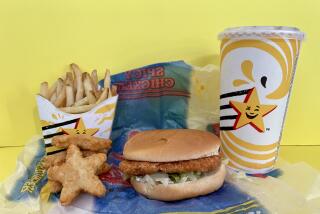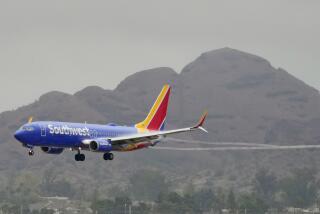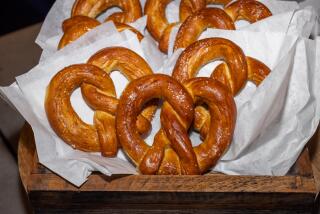Some Airline Meals Begin to Rise to the Occasion
- Share via
Twice each week, when Alaska Airlines chairman Bruce Kennedy and the top 13 officials of the company sit down to eat lunch together at their corporate headquarters in Seattle, their meal is a mystery until it is served. There is no menu and no choice of entree.
Instead, each Monday and Thursday, Kennedy and his associates are served whatever their passengers are eating that day on flights leaving such cities as Fairbanks, Las Vegas or San Francisco.
During lunch Roger Kubler, Alaska Airlines assistant vice president of in-flight services, stays close to his phone at the Seattle Airport. “If it rings within the first 15 minutes,” he says, “I know we’re in trouble.”
Lately, Kubler’s phone has been quiet. But it wasn’t always that way. “There was the bad lasagna a few years back,” he laments. “No amount of ricotta cheese could have saved that one,” he says. “And they killed me on the tacos.”
A 1979 attempt at flank steak was a disaster. “It was really mystery meat,” he says. “We figured it had been tenderized and needled by a rampaging dental technician. It was edible, but honestly, the only thing it was good for was to possibly patch a hole in your luggage.”
Buried in Alaska
In 1983 there was the infamous strawberry waffle the airline tested on its Seattle to Anchorage flights. Rumor has it that the unsuccessful waffles are buried somewhere in Alaska.
Alaska Airlines passengers were spared these painful gastronomic experiences. “We have no pride of authorship when it comes to bad airline food,” Kubler reports. “If we don’t like it, we dump it. The food was edible, and it was safe, but we just didn’t like it.”
As a result of all the testing, the airline can boast one of the best reputations for in-flight food in the nation on its 130 flights each day that serve meals. Menus feature items such as trout stuffed with shrimp and crab in a Wellington pastry. There are fresh appetizers and service is on china, not plastic.
In many respects, Alaska Airlines is the exception to the traditional reputation of airline food. On many U.S. airlines the meals served resemble toy food or, as one friend describes it, food that looks as if it had been placed in a time capsule and recently unearthed.
Prized Peanuts
Unfortunately for many travelers, the one pleasurable airline food experience may be the small bag of honey-coated peanuts often handed out.
But now, thanks to airlines such as Alaska on the West Coast and Air Atlanta in the Southeast, other carriers are taking a closer look at their food service, and things are starting to improve.
“There’s no doubt,” says Alaska’s Kubler, “that we helped to force the food issue.”
United Airlines is concentrating more on its food service on routes where they compete with Alaska. And the food service has definitely improved.
Recently I flew via United between Seattle and LAX. The lunch offered in coach was simple and good: a green salad, a pita sandwich stuffed with salami, cheese and ham, and an all-natural butterscotch brownie.
Such airlines as PSA, which had never offered meal services, now provide them on their longer coastal runs, and they’re also pretty good. But don’t just take my word for it. Ask Bryan and Chris Pierce, my young seatmates on a crowded 7:25 a.m. PSA breakfast flight.
The two Pierce kids, from Auburn, Wash., were on their way to a family vacation at Disneyland and deeply involved in their Mad magazines during takeoff.
Fifteen minutes later the flight attendants went down the aisle and handed out plastic see-through boxes.
I didn’t notice the food. I wasn’t particularly hungry and, after all, how good could airline food be, especially at 7:40 in the morning? I continued to read my own magazine. But not for long.
Youthful Approval
“Oh, wow!” exclaimed 11-year-old Bryan, putting down his magazine. “This is neat!”
Airline food? Neat?
I looked into my box.
Bryan wasn’t kidding. Inside the box were a fresh croissant, cheese, crackers, grapes, honeydew melon, strawberries, peanut butter, more crackers, cottage cheese and a wrapped chocolate mint (something for everyone).
“This is much better than when we flew Delta,” said Bryan’s older brother, Chris. “They just gave us these tough eggs.”
Tough eggs--otherwise known as the notorious breakfast omelet. On some airlines the omelets are so hard and bland that some flight attendants joke that they can be used as flotation devices in the event of a water landing.
However, the much-maligned omelet is not alone in this category, because much of what you eat on an airline is food that has been reconstituted. And some foods survive reheating better than others. But not many.
That may be one reason why some carriers have given up on much of their hot food service. “Many passengers think that if food is hot it costs more. Not true,” says Robert Zoller, PSA’s director of flight operations and in-flight passenger services.
“The main idea,” he says, “is to keep the food fresh, simple and nutritious. We are also concentrating on low-calorie, low-sodium meal items.”
For example, Zoller is modifying the airline’s menu specifications to use whole-grain breads and rolls. PSA has also been testing all-natural cookies. And yes, the airline estimates it will distribute more than 9 million packets of those honey-coated peanuts this year.
The Cost Factor
Another airline that has taken a close look at its food service is Republic. “One of the reasons we re-evaluated our food service,” says Jim Jette, director of food service, “is that what we do serve on an aircraft we want to do well.
“I’d be stupid to tell you that we don’t take food pricing into our thoughts,” says Jette, who manages a $50-million annual food service budget for Republic. “Some airlines can serve eggs Benedict, but we know they can’t always do it right. We don’t want to take that chance.”
Instead, a little more than a year ago Republic made the switch to cold food on almost all flights. “We’ve had fewer complaints,” says Jette, “and we feel that the meals are also healthier.”
With few exceptions, almost every Republic meal served contains fresh vegetables or fruit. And, almost every meal doesn’t contain heavy sauces. “I’m totally against sauces,” Jette says, “because many times they’re used to disguise bad meals.”
Jette also tries to plan meal flights based not on departure or arrival times but on what he calls the passengers’ “estimated local stomach time.”
Republic, which just opened a flight kitchen in Detroit, works closely with its catering staff to plan the most appropriate airline meals. Often the airline will commission time and motion studies to determine which foods to serve on which flights, based on the length of the flight and the time it takes the flight attendants to prepare and serve the meal.
But when it comes to airline food, all the market research in the world can’t always anticipate passenger preferences. On a Republic flight between Houston’s Hobby Airport and Memphis, the airline switched from a cold meal back to a hot one. “This flight is popular with businessmen,” says Jette, “and they just didn’t perceive the cold food as a real meal, even though it cost us more.”
More Miles, More Money
On longer, international flights, airline expenditures for food are much higher. British Caledonian, for example, spends as much as $60 per first-class passenger, $38 per business-class passenger and $21 per coach passenger for meals for flights between the United States and the United Kingdom.
Airlines such as Lufthansa have pioneered the cold food approach on their short, inter-Europe hops. It’s not unusual to see a few hundred plastic bags hanging from a large metal rack by the entrance to some flights. As passengers board, they take one of the bags. Inside, they’ll usually find a fresh sandwich, cheese and an apple or orange. It’s a successful service that some U.S. airlines are studying.
But until that happens, it could pay to do a little homework before you get on your flight. It’s often healthier to request a vegetarian meal, or a fruit plate. Kosher meals also tend to be healthier than a reheated steak coated with secret sauce. Most airlines will accommodate your request, if you make it at least 24 hours before your scheduled departure time.
And with any luck at all, if worse comes to worst, there are always the packets of those honey-coated peanuts.
More to Read
Sign up for The Wild
We’ll help you find the best places to hike, bike and run, as well as the perfect silent spots for meditation and yoga.
You may occasionally receive promotional content from the Los Angeles Times.






